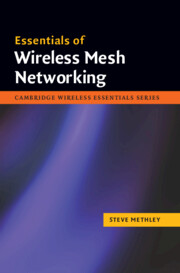Book contents
- Frontmatter
- Contents
- Preface
- Acknowledgements
- 1 Mesh overview and terminology
- 2 Attractive mesh attributes and applications
- 3 Fundamentals of mesh technology
- 4 Mesh capacity, scalability and efficiency – hypothesis testing
- 5 Mesh susceptibility
- 6 Mesh services and quality of service
- 7 Summary of potential mesh pitfalls to avoid
- 8 Appropriate telecommunications applications for mesh
- 9 Successful mesh implementations
- 10 Wireless sensor networks (WSNs) as mesh networks
- Abbreviations
- Selected definitions
- Appendix: Mobility models
- About the author
- Index
- Mesh hints and tips
6 - Mesh services and quality of service
Published online by Cambridge University Press: 01 March 2010
- Frontmatter
- Contents
- Preface
- Acknowledgements
- 1 Mesh overview and terminology
- 2 Attractive mesh attributes and applications
- 3 Fundamentals of mesh technology
- 4 Mesh capacity, scalability and efficiency – hypothesis testing
- 5 Mesh susceptibility
- 6 Mesh services and quality of service
- 7 Summary of potential mesh pitfalls to avoid
- 8 Appropriate telecommunications applications for mesh
- 9 Successful mesh implementations
- 10 Wireless sensor networks (WSNs) as mesh networks
- Abbreviations
- Selected definitions
- Appendix: Mobility models
- About the author
- Index
- Mesh hints and tips
Summary
In this chapter we will show that a startling effect in meshes is that quality of service (QoS) is not under the operator's control but depends on mesh node behaviour. In a mobile mesh, this means that your QoS depends on your neighbours' behaviours at any point in time, potentially spanning a range all the way from having no discernable effect up to a complete loss of your service. There is nothing quite like this problem in the networks we commonly use today.
But we begin this chapter by looking at how QoS is defined and what QoS levels are required for the applications of today and into the future. Following this we look at whether there are any useful services which truly only a mesh could support. After considering node mobility and showing how node to node relative speed is the key parameter, we look at an example of how a mesh may break into disconnected pieces. This can occur before the full mesh capacity is approached. Finally we show that mesh quality of service is not entirely within the control of the network operator, but rather depends on user mobility and traffic, before showing how adding infrastructure can help improve the quality of service position. Mitigation techniques for QoS issues induced by normal user activity include the provision of extra network-owned nodes in order to regain some control, but this comes at a cost for the operator.
- Type
- Chapter
- Information
- Essentials of Wireless Mesh Networking , pp. 134 - 150Publisher: Cambridge University PressPrint publication year: 2009



